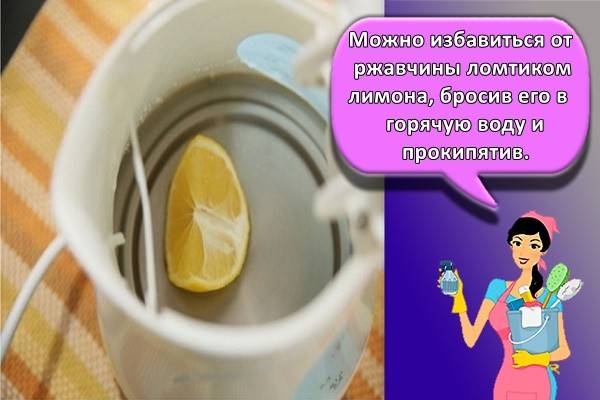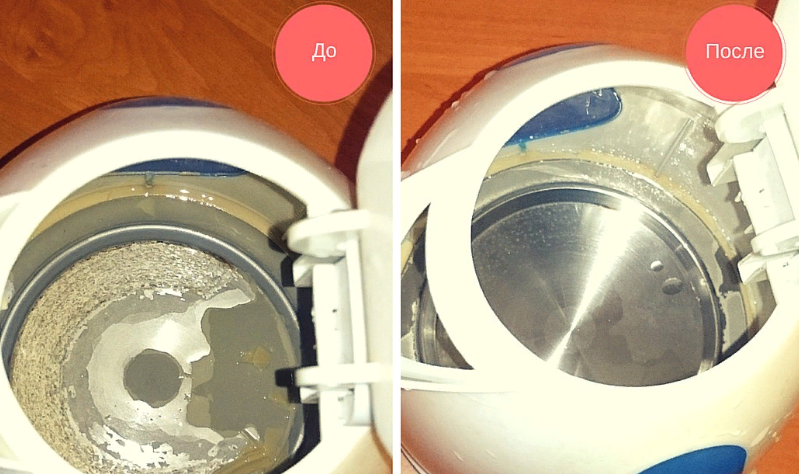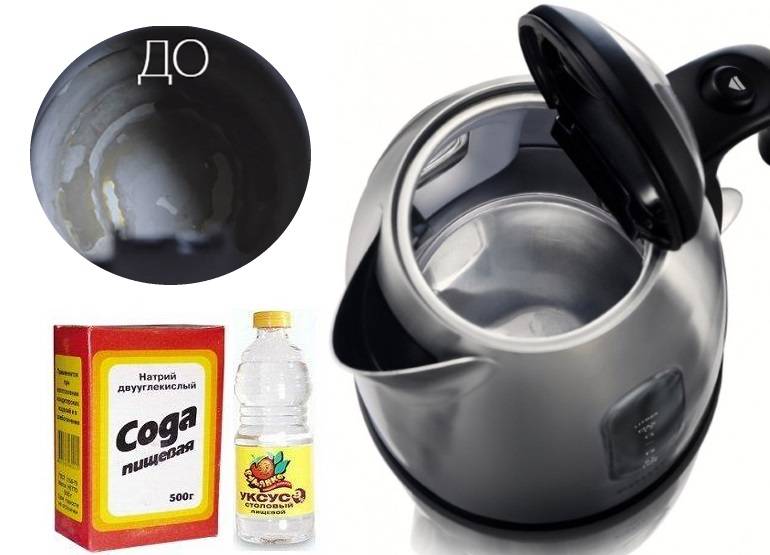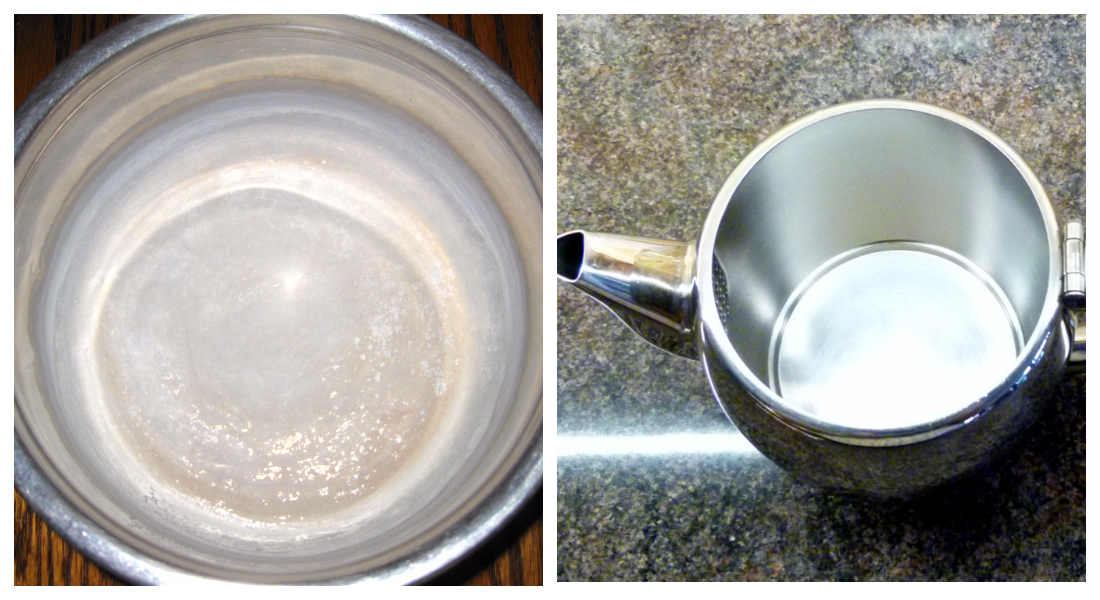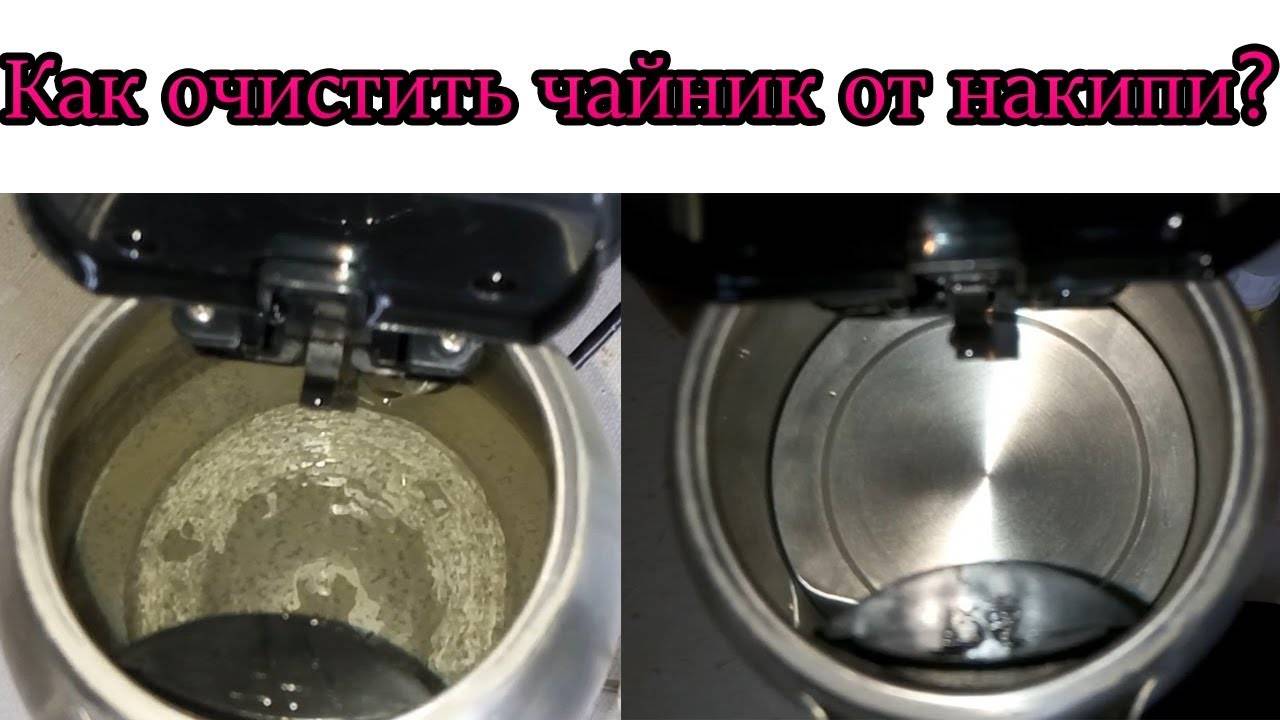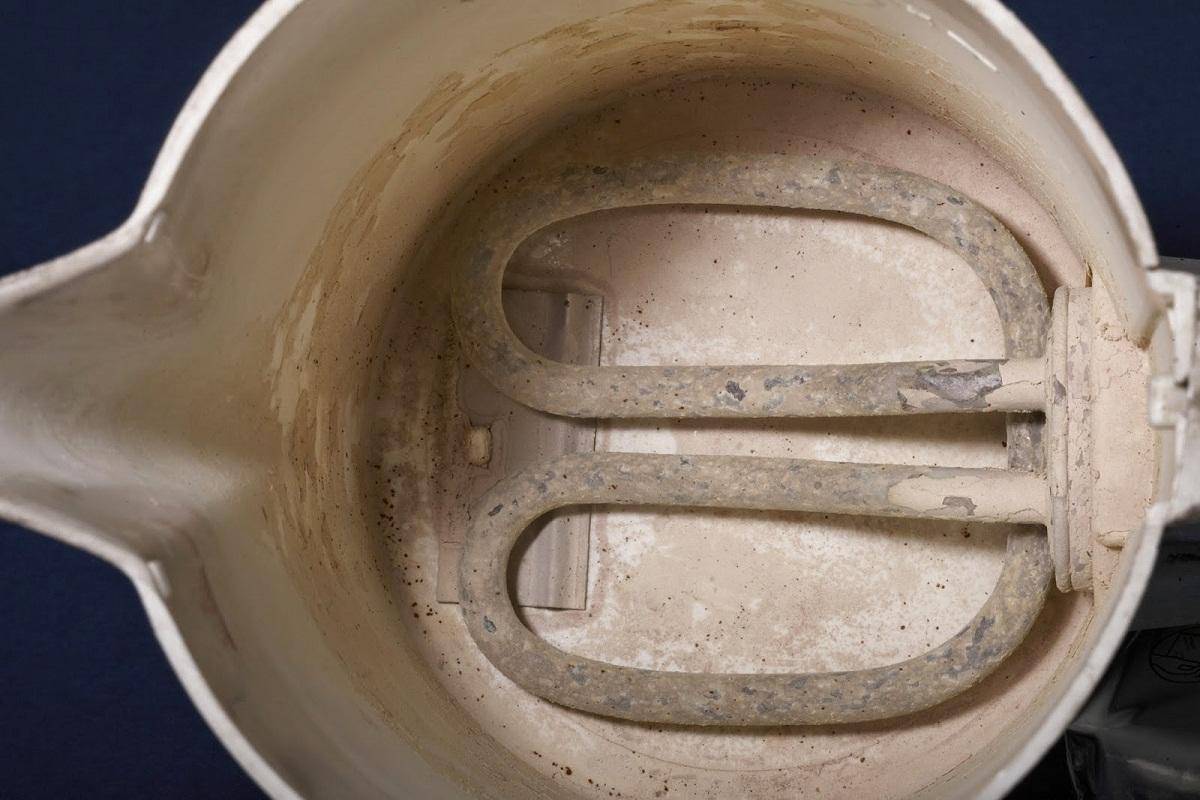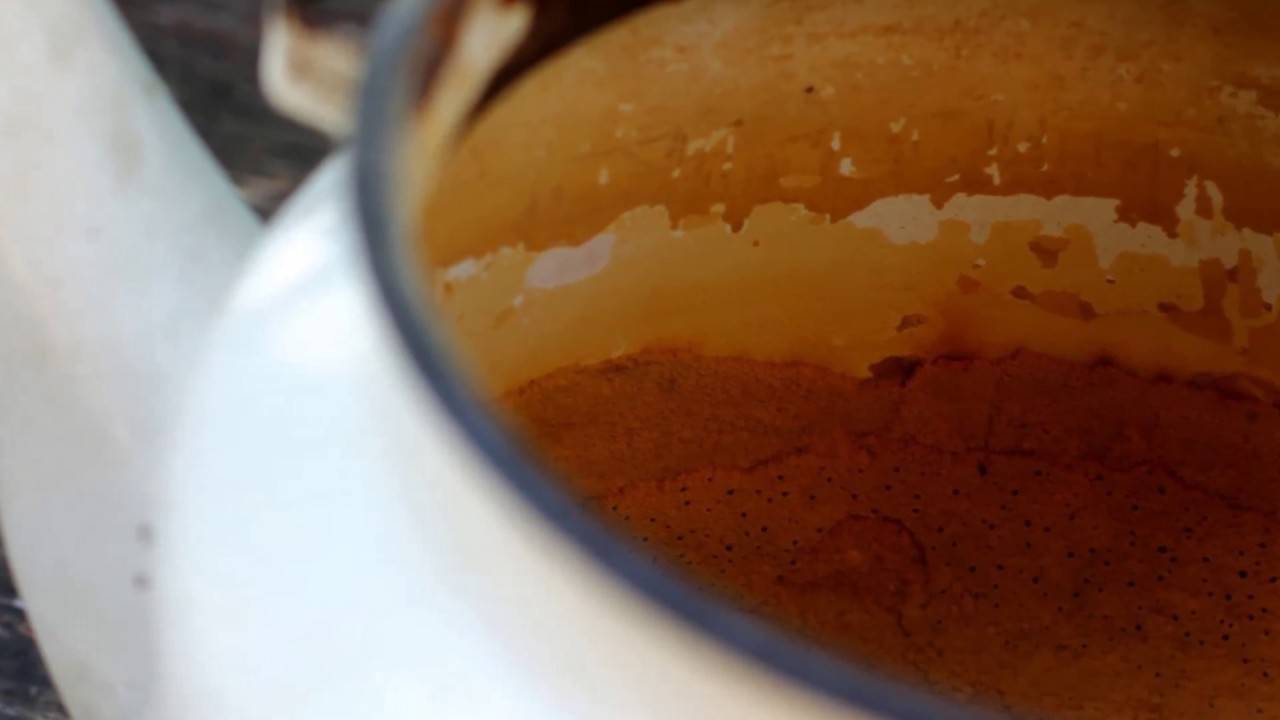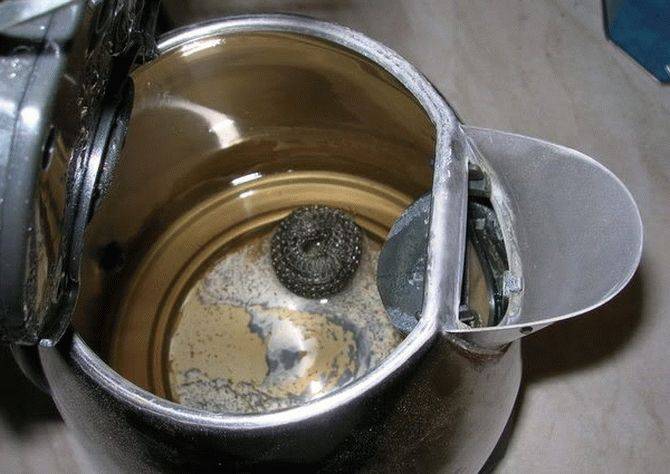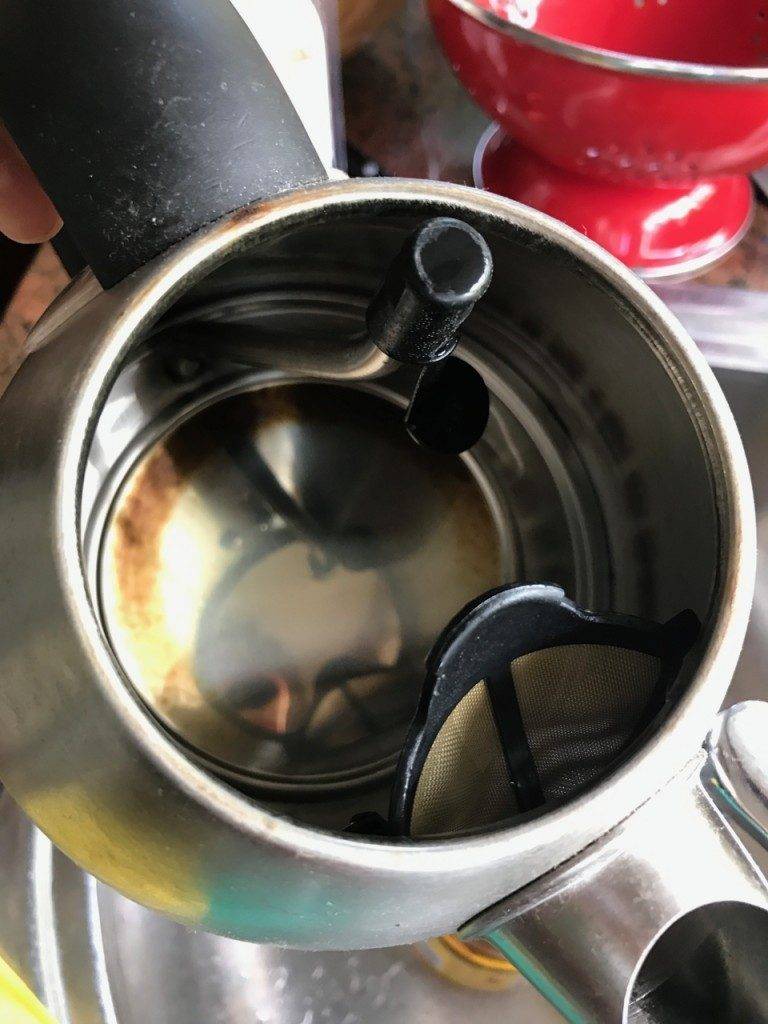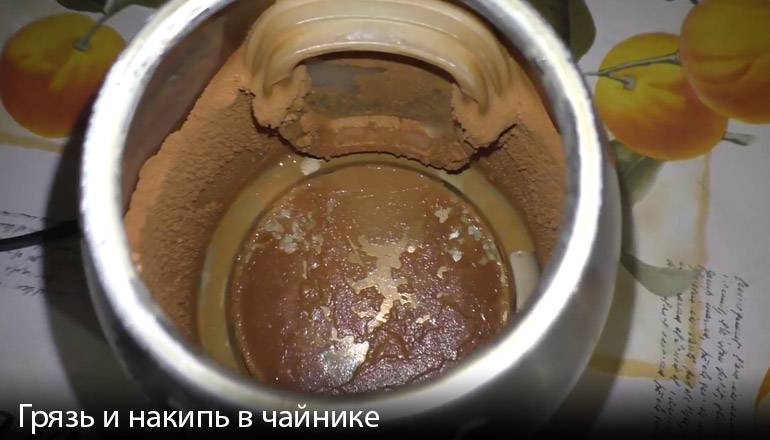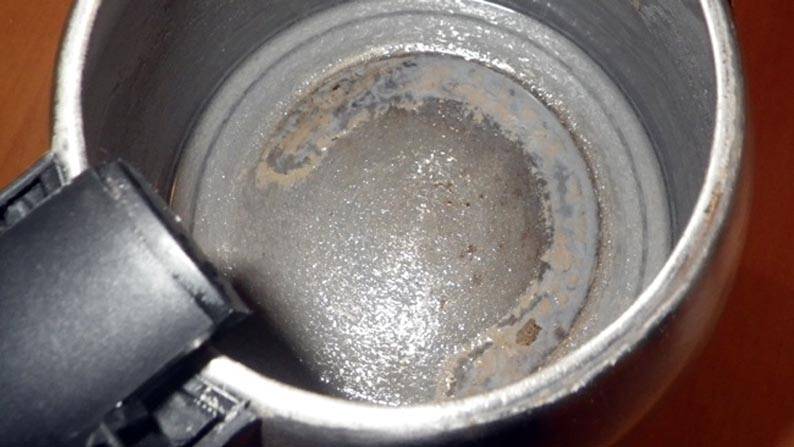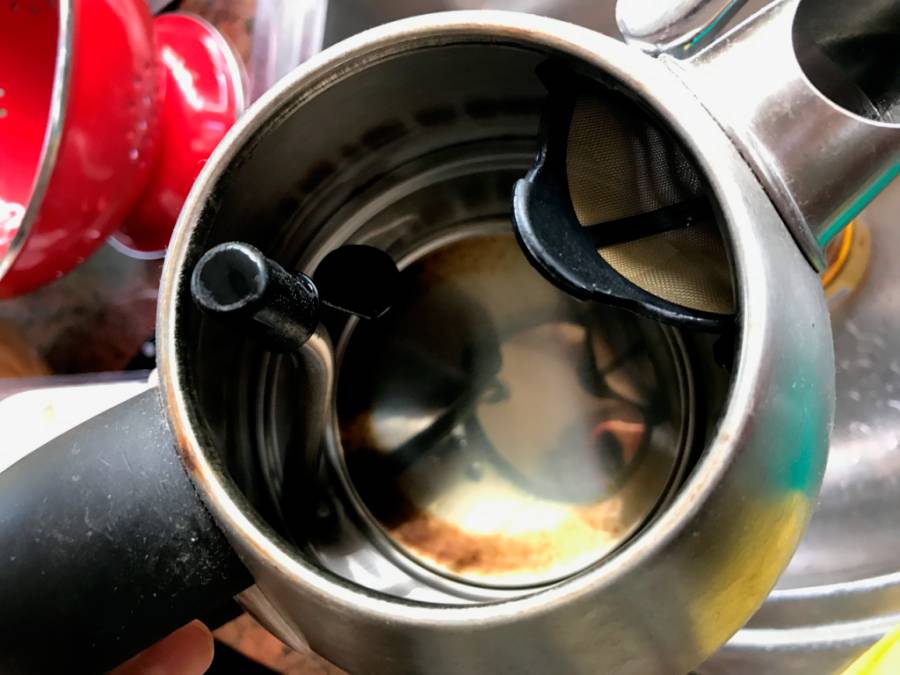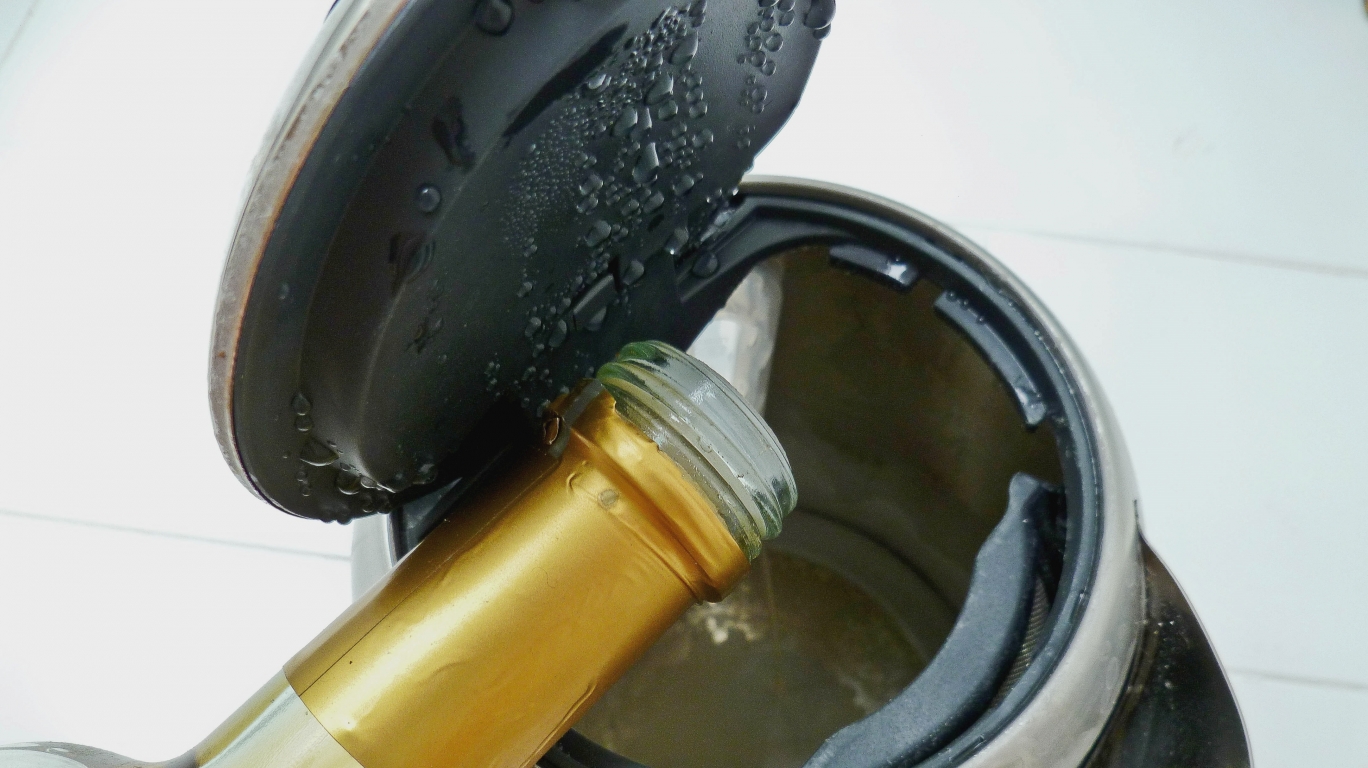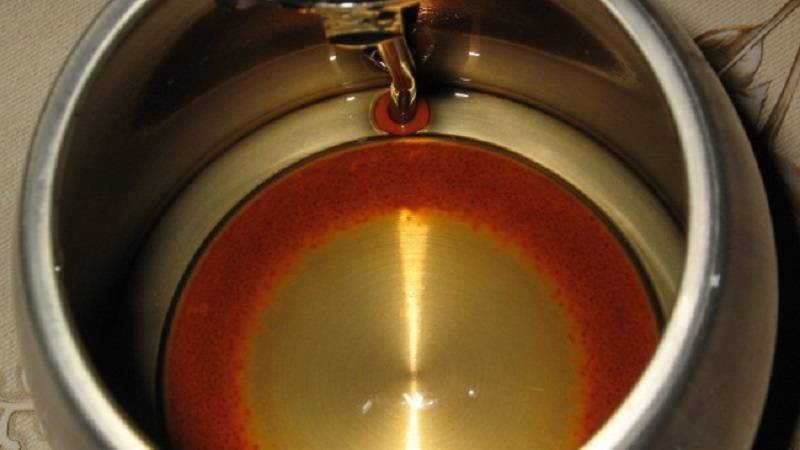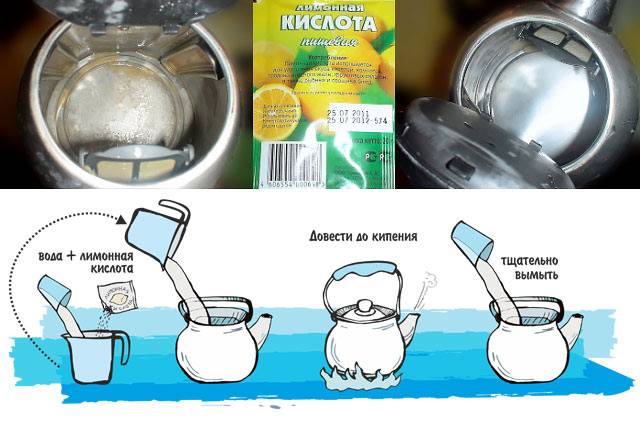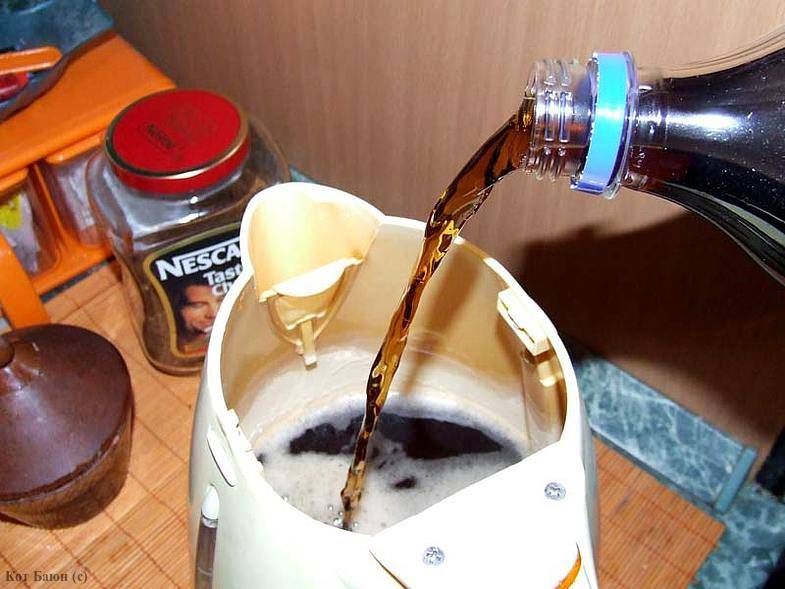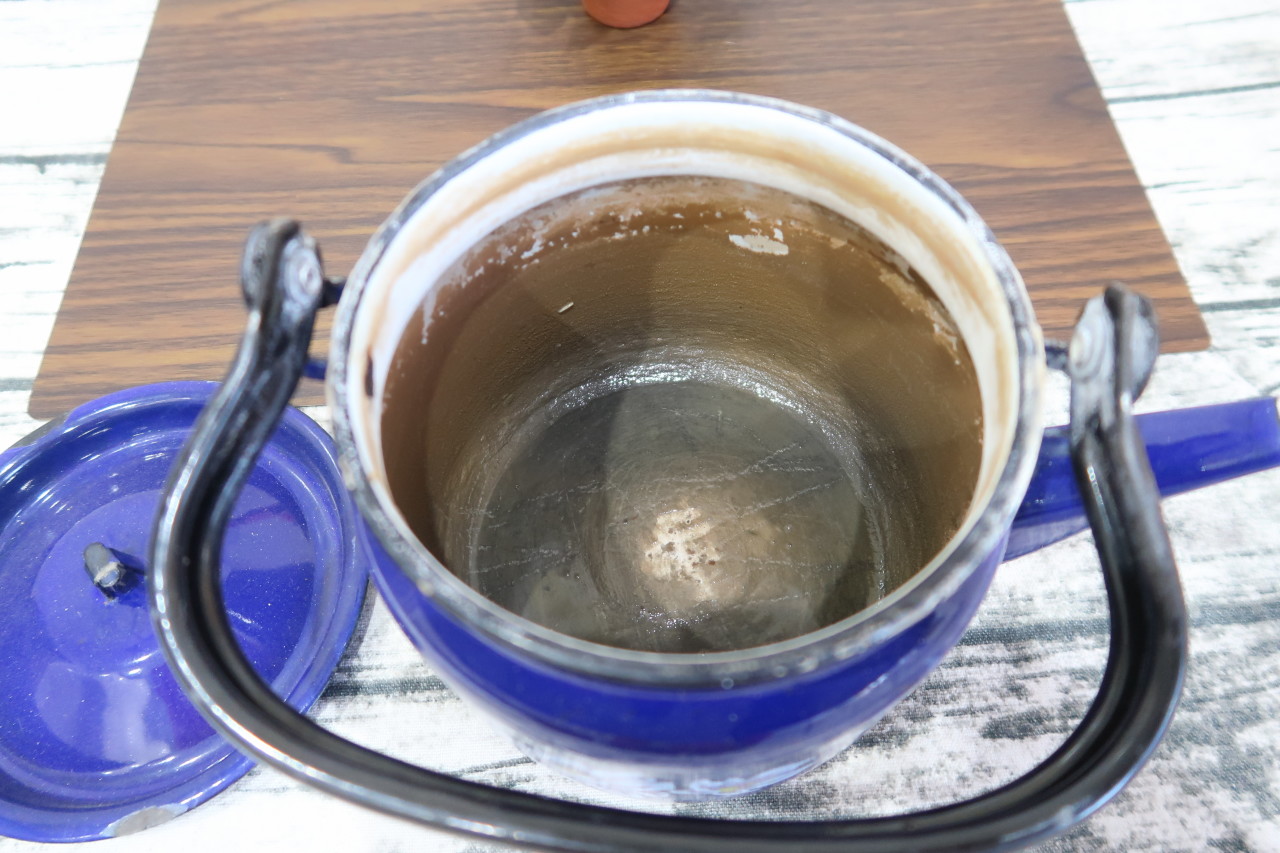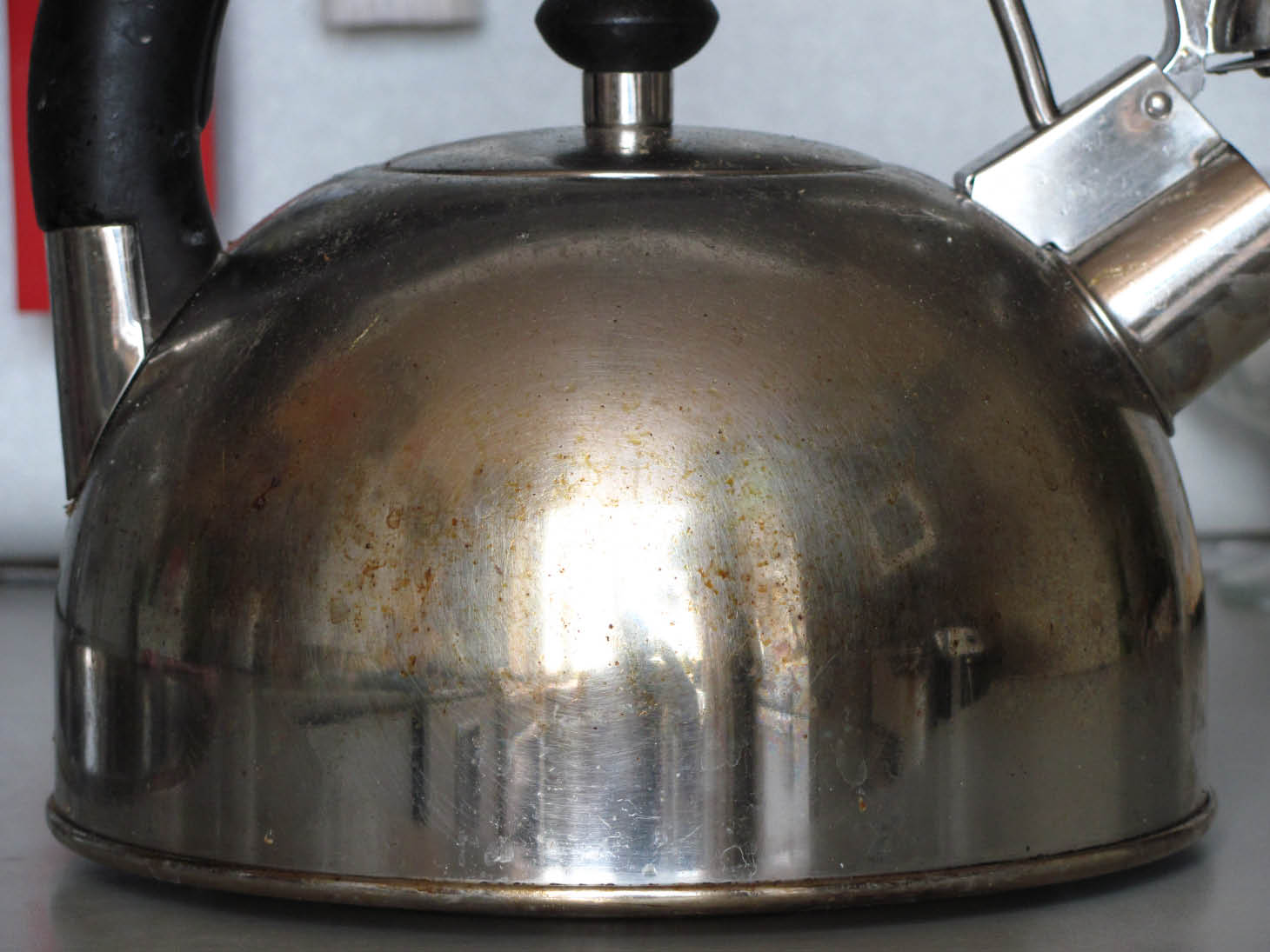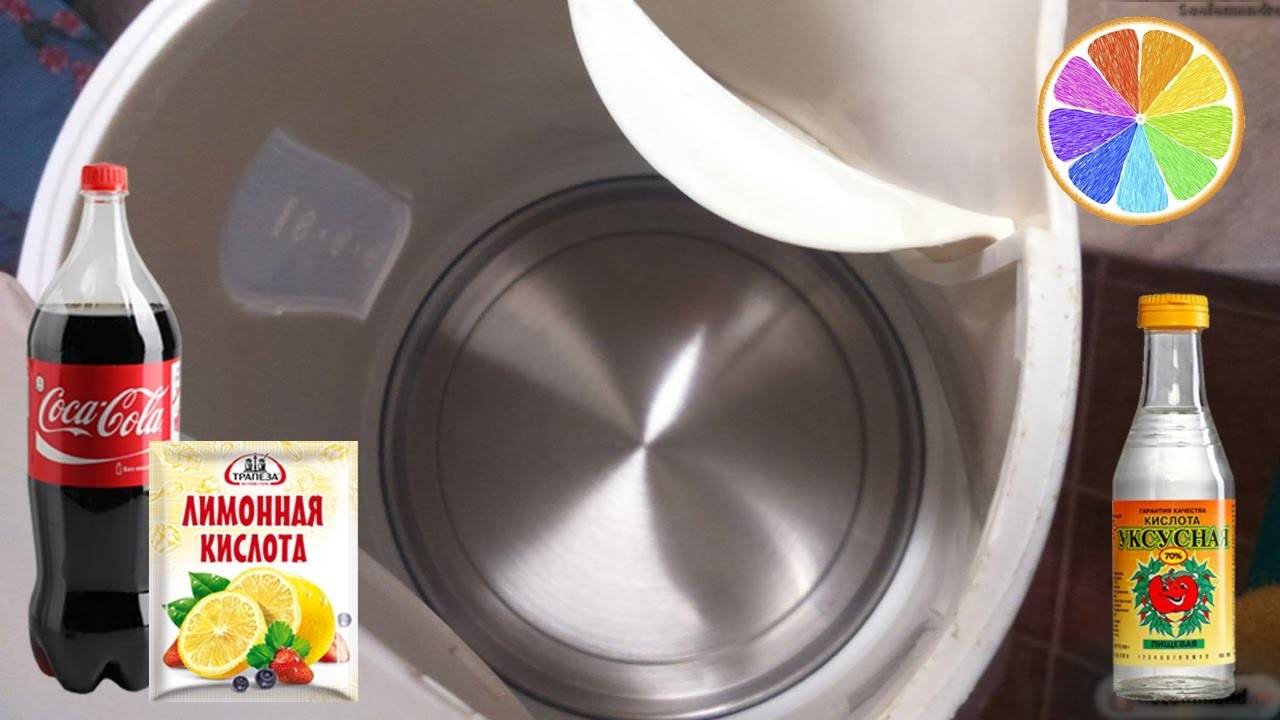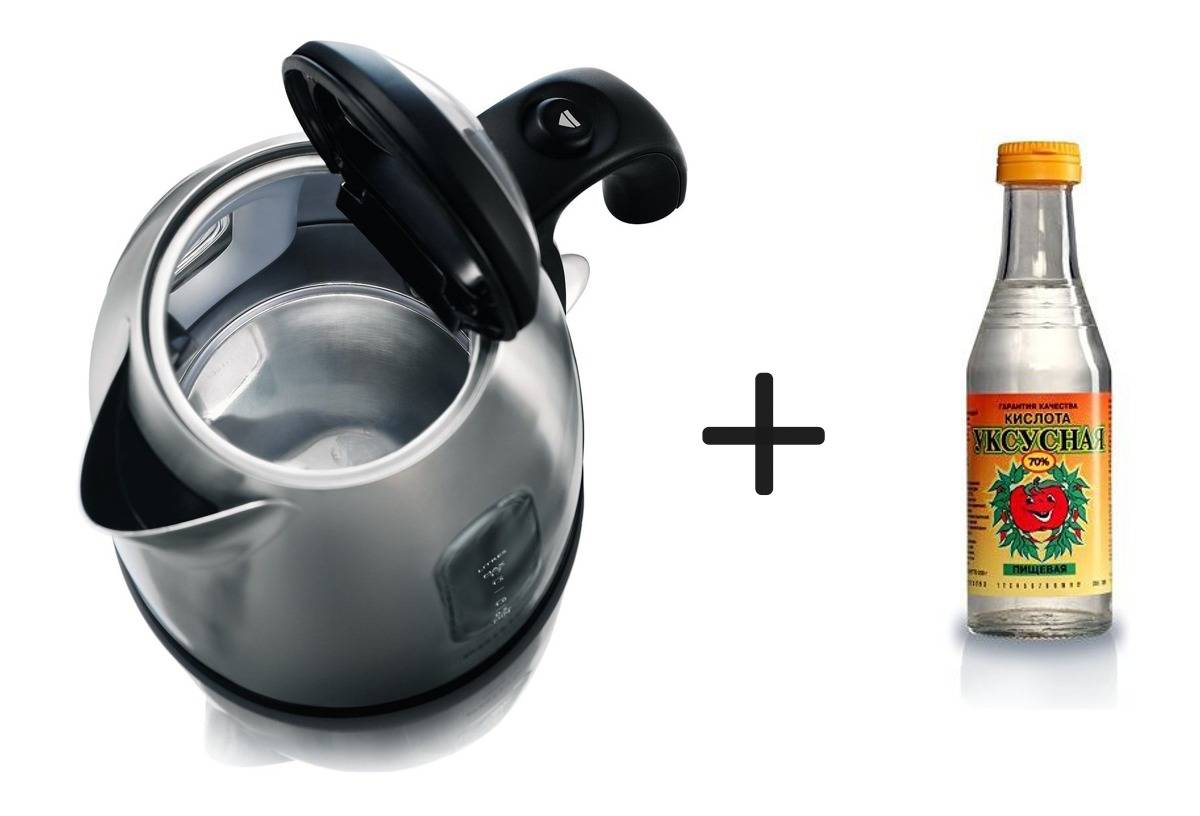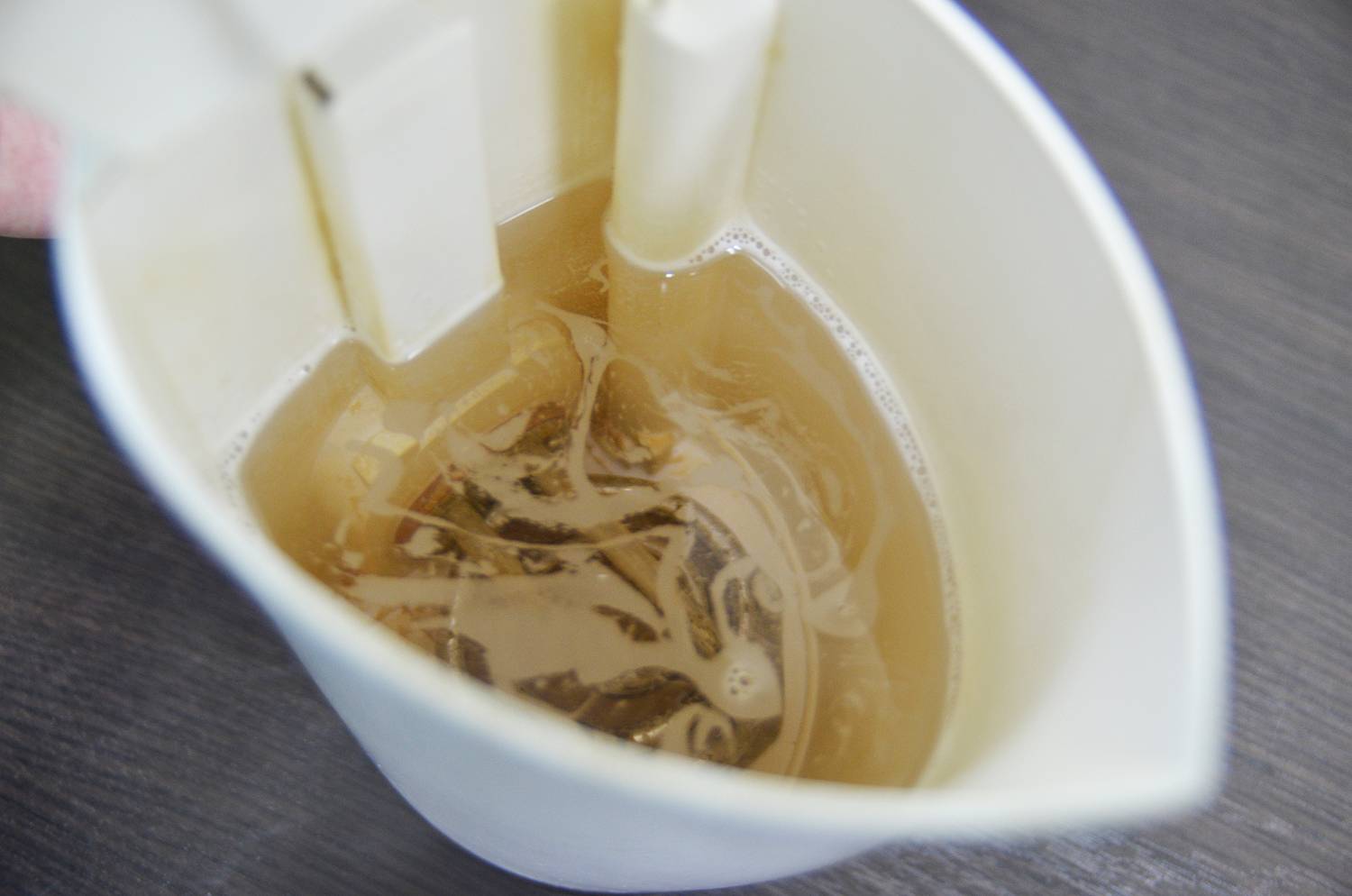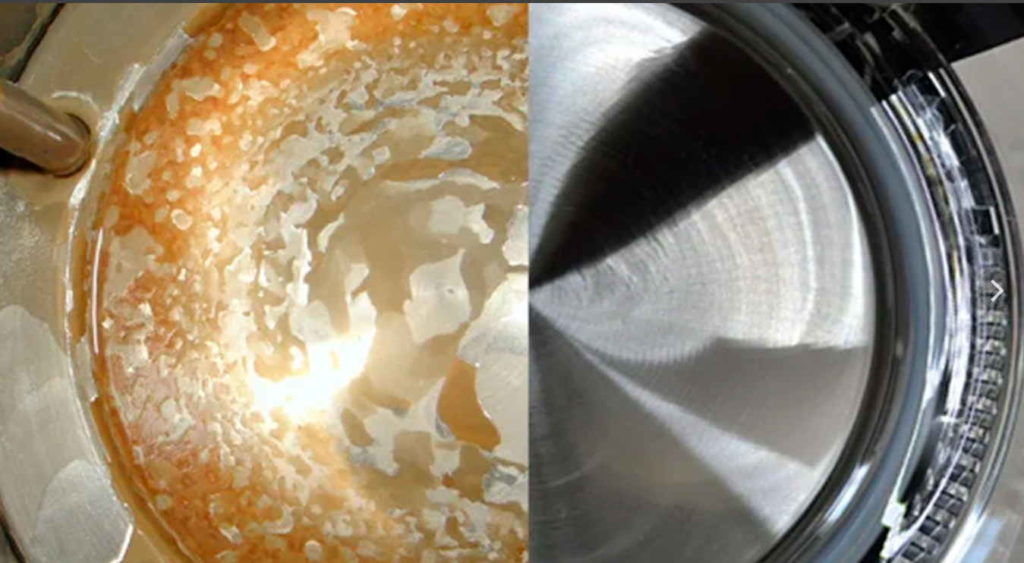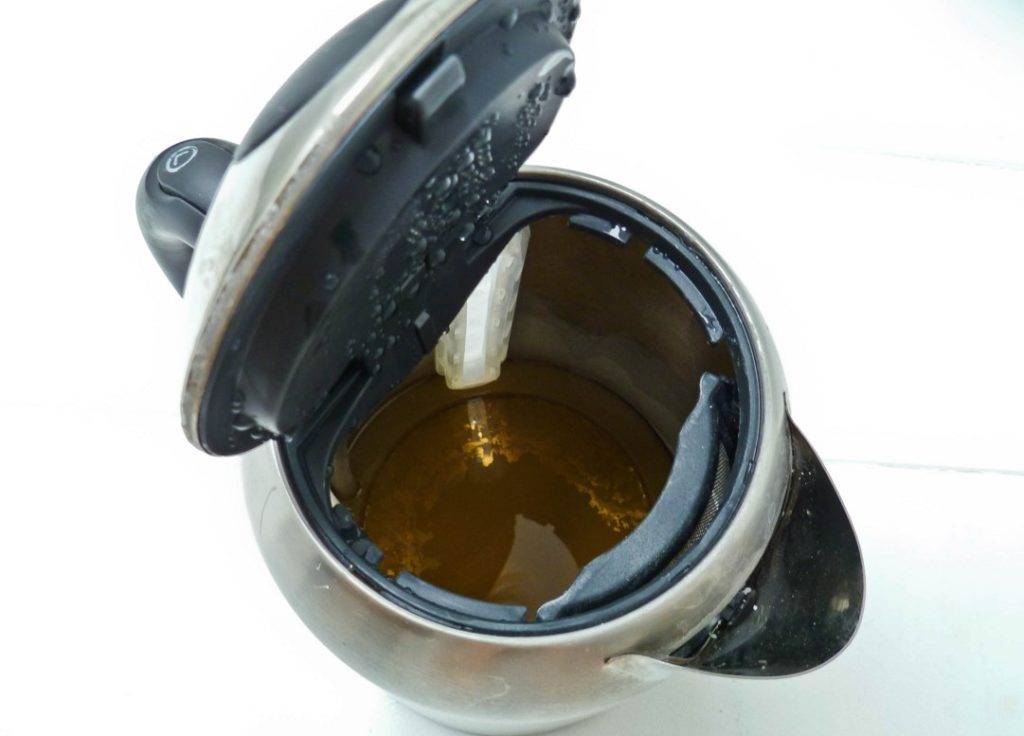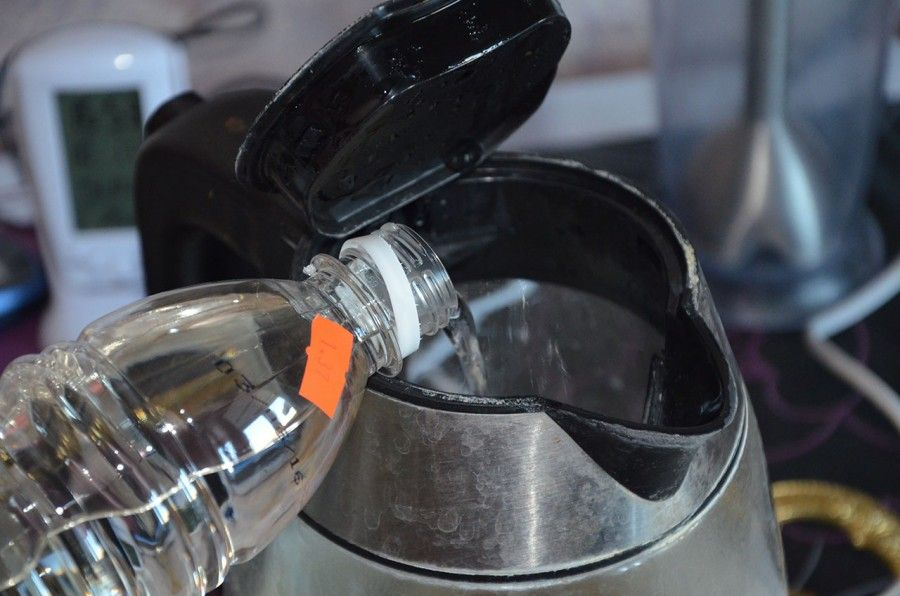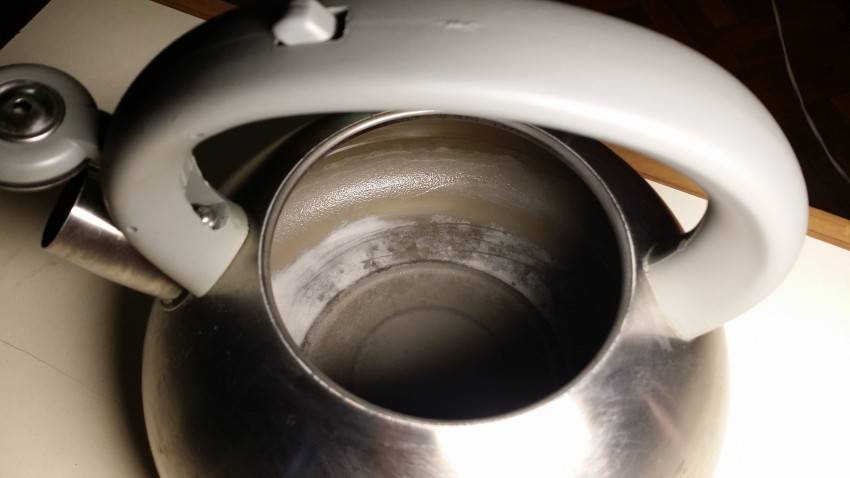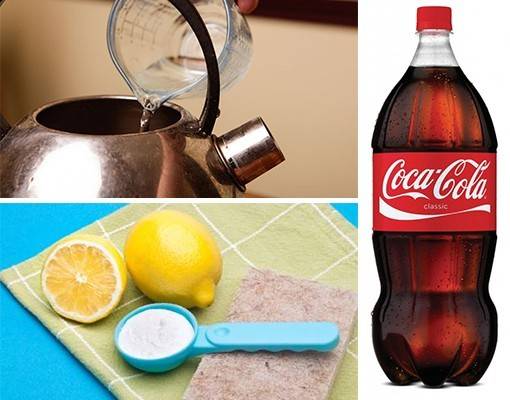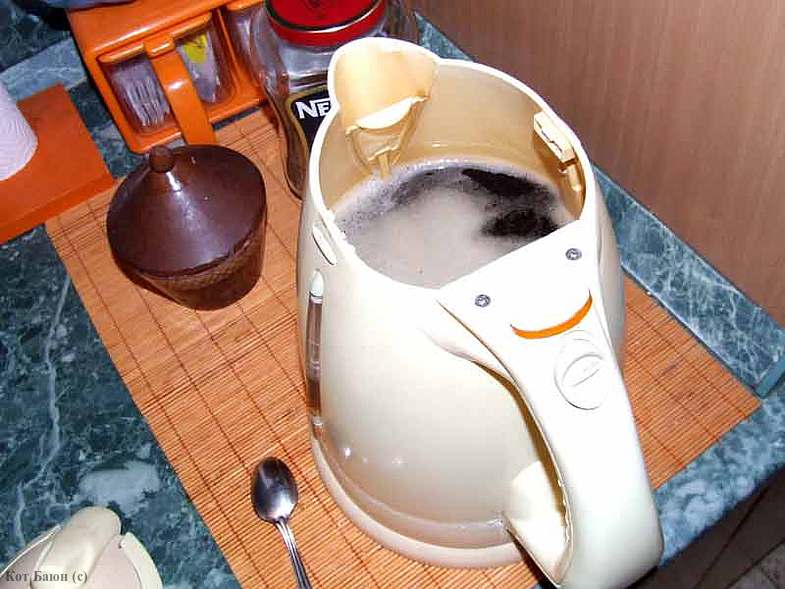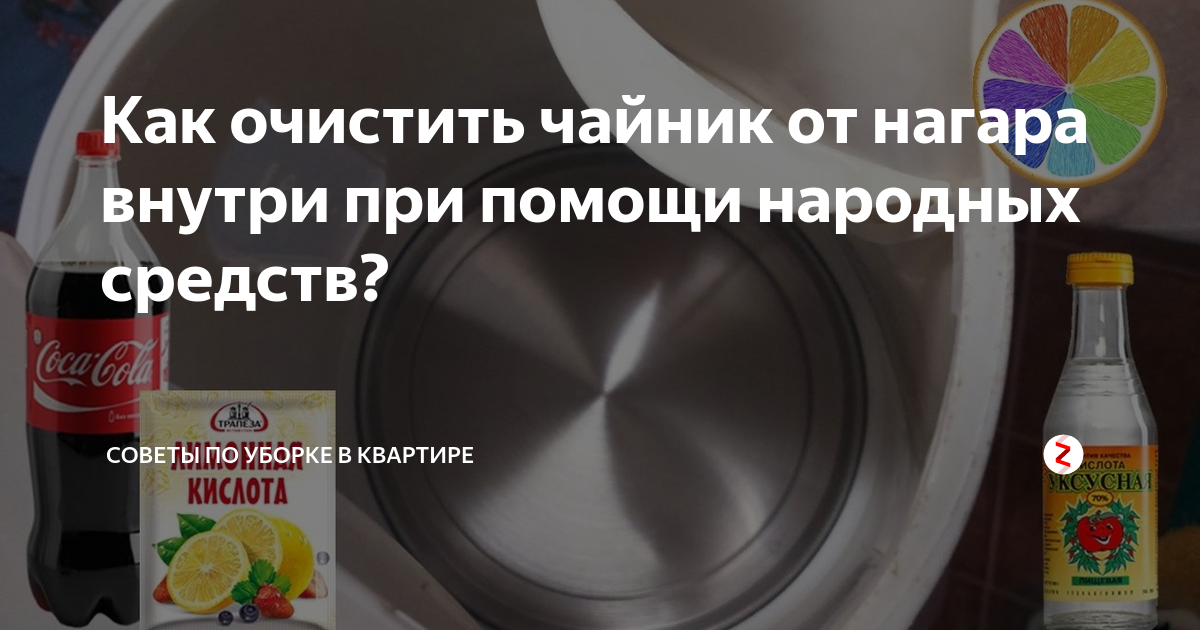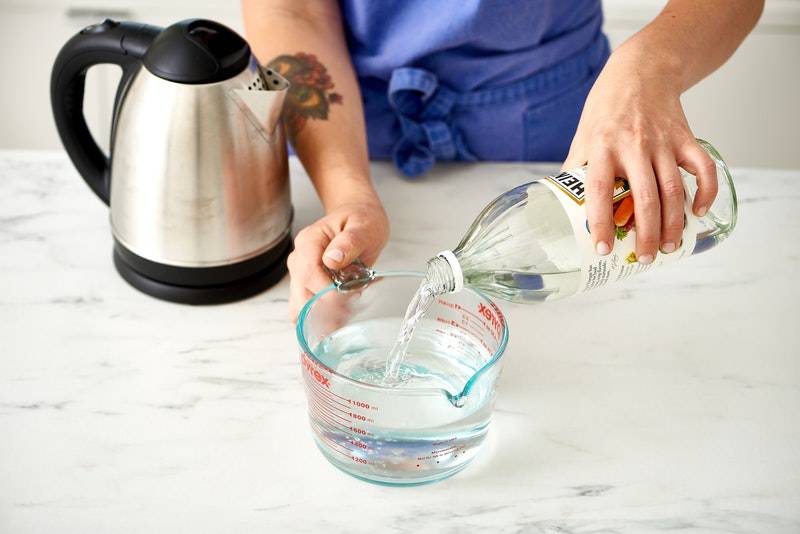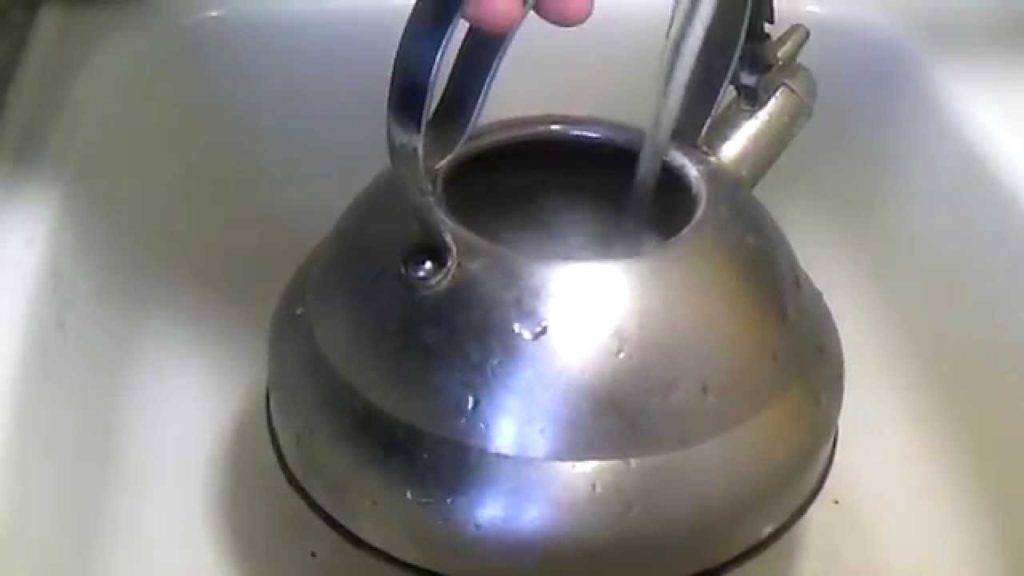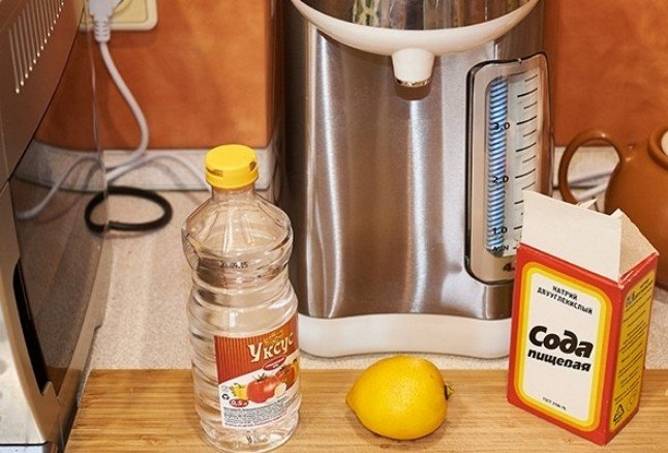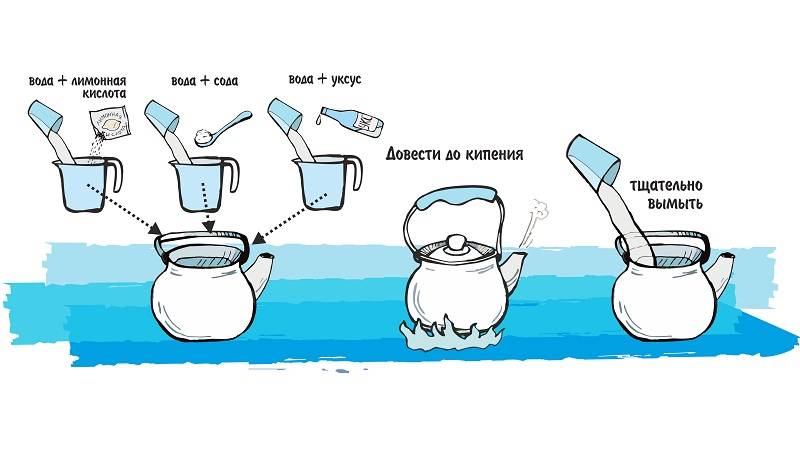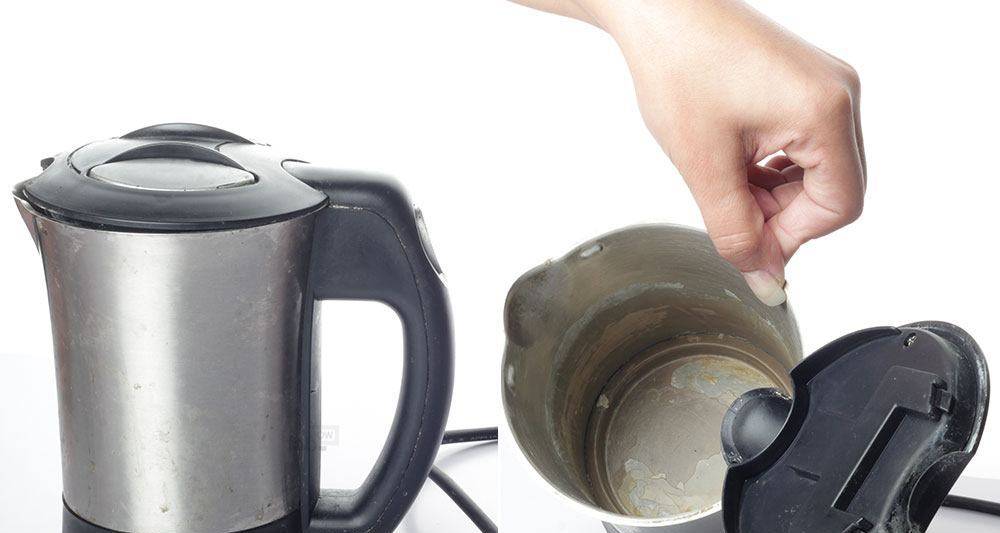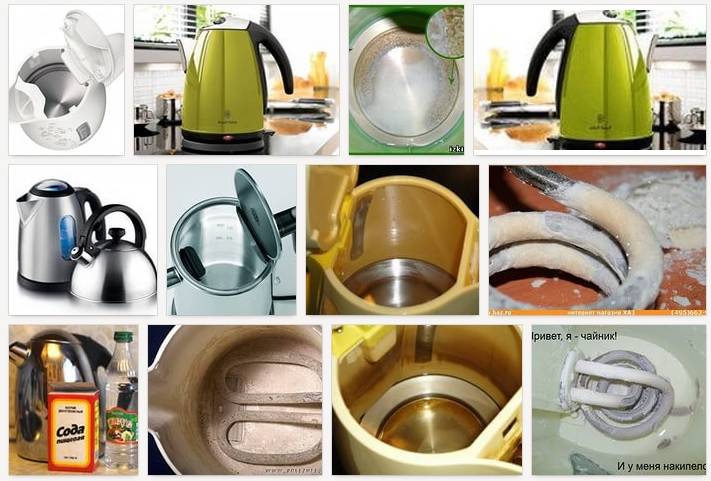How can you clean your kettle
You can get rid of iron oxides in the form of a dark coating in a teapot in different ways, the main thing is to use them correctly. The most effective solution to the problem will help citric and acetic acid. These are organic acids that do not have a very strong effect on the metal. At the same time, they easily remove the deposits formed on its surface, which are loose in structure.
We use acetic acid
This is one of the simplest and most affordable tools that you can use to deal with not only rust in the kettle, but also scale.
- It is necessary to prepare table vinegar 6-9%.
- Fill the dish with water three quarters of its volume.
- Bring water to a boil and turn off.
- Pour in the vinegar solution in the amount of the missing quarter of the kettle's volume.
- Soak for eight hours or leave in this form overnight.
- Drain the solution and rinse thoroughly several times with water.
The smell of vinegar is very persistent, and it may require boiling a few new portions of clean water to get rid of it.
In severely neglected cases, one procedure is not enough. Therefore, it will have to be repeated.
Only steel teapots are cleaned with acetic acid, plastic ones can be damaged. They are cleaned with the addition of baking soda:
- pour water, vinegar and add one tablespoon of soda;
- as soon as the violent effervescent reaction ends, the resulting liquid is allowed to boil, poured out after cooling;
- finish cleaning by rinsing with clean water.
We cleanse with citric acid
Unlike vinegar, citric acid has no pungent odor. Therefore, when choosing a method of dealing with rust, preference is given to it.
The cleaning procedure is carried out in the same way as with acetic acid, but with some simplification. The kettle is completely filled with water, brought to a boil and 1-2 tablespoons of citric acid are poured into it. After cooling, the solution can be drained, wiped inside with a soft sponge, rinsed thoroughly clean water and boil clean water again. If rust appears on the outside, it can also be cleaned with a citric acid solution.
You can replace powdered citric acid with lemon fruit. To do this, just cut it with the peel and boil in a teapot for 10 minutes.
The use of citric acid and vinegar was recommended by the well-known manufacturers of household appliances Tefal and Philips.
The appearance of rust in the teapot
Indescribably lucky people who have access to high-quality water in all respects. Many people have to use hard water with a high content of various mineral salts and trace elements for drinking and cooking. If there is a lot of iron in the water, rust will form on the sides of the pot and in the kettle.
Why you need to delete
Just a few boils of water are enough for this rusty sediment to form on the inner wall of the kettle. In addition to the unpleasant look inside, there are other reasons why you need to clean it from rust:
- A specific taste appears that does not allow you to enjoy the aroma of freshly brewed tea or coffee.
- In electrical appliances, deposits on the heating coil interfere with heating. The boiling time increases by an order of magnitude.
- Many housewives throw away a working kettle only because of the brown rust inside.
Removing from an enamel teapot
Enamel teapots require careful handling. You cannot scrape them with a knife, metal brushes. In places where the enamel is chipped, rust begins to appear. Plaque spreads over time inside the dishes and leads to cracks.

Folk ways
It is better to clean the inner container of the kettle with those chemicals that are constantly used in everyday life. They will help you tidy up your enamelled kitchen utensils.
Peel from fruits and vegetables
Potato peelings, apple peels, pears are used for cleaning enamel dishes. Put the washed pieces into a container, pour water and put on fire. Boiling in a few minutes will keep the utensils clean. If rust has just appeared, then you can wipe the damaged areas with a piece of apple or half a potato dipped in vinegar.
Spoiled milk
Acid is formed in sour milk. She can successfully wash off the rust that has appeared inside the kettle. You can wipe the stains with the product, leaving them for 5-7 minutes. Then carefully wipe off with a sponge and rinse with clean water.
Lemon acid
Citric acid crystals fight rust stains inside dishes. It is necessary to rub the damage with a slice of lemon. Then rinse off with clean water. You can get rid of plaque with a solution prepared from water and 2-3 tablespoons of citric acid. Boil water in a kettle for 30 minutes, then rinse it under the tap.
Vinegar
The essence is poured into water, diluted in a ratio of 1:10. Boil in a kettle for 20 to 30 minutes. Then the kitchen utensils are thoroughly rinsed to get rid of the rusty deposits inside.
You can remove rust from enamel with baking soda gruel. For the procedure, use a damp sponge or cloth. At the end, rinse the inside of the kettle with water.
Industrial remedies
Rust and deposits from the walls of kitchen utensils are removed with products such as Pulsar Kalk Free. It is enough to take 30 ml of concentrate per liter of water. Apply the liquid to the area of rust, leaving it for 5-7 minutes. Then wipe with a sponge and rinse.
It is easy to remove various deposits with a mixture of mineral and organic acids of the Antirzhavin preparation. The concentrate is applied to damaged areas, washing off after 7-10 minutes. After application, the product leaves a film on the surface that protects against subsequent corrosion.
Folk remedies for rust
Home remedies, proven over the years, are the safest in the fight against scale and rust. Especially suitable for plastic teapots.
Lemon acid
Acid is one of the mildest remedies. It can be bought at a regular grocery store in 25 gram sachets. The composition for processing includes: 10 grams of acid per 1 liter of water or pour 1 sachet into 1 full teapot. Then turn on the device.
The liquid is brought to a boil and the kettle is turned off as a result. If the cleaning steps are not followed correctly, boiling water can begin to foam and, as a result, splash up. Leave the hot solution to cool for 15-20 minutes. After this time, pour out the solution.
Note! The remains of the solution must not be used for other purposes. Thoroughly rinse the kettle inside and out, if it is heavily soiled, repeat the procedure again
Acetic acid
It is an effective reagent for removing rust, since, when reacting, it decomposes salts into simple substances. The method has been used for many years and is called "grandmother's". A 10% solution is suitable for the procedure, which can be found in any kitchen.
The proportion for an ordinary kettle with a volume of 1.5-2 liters is equal to 2 cups of vinegar. Then all the actions described in the previous method are performed.
Note! The disadvantage of this method is the smell, so you need to take care of airing the room in advance.
Soda solution
Dilute the baking soda with water, resulting in a thick mass. Put the gruel inside the teapot for 20 minutes. Then, using a steel bristle brush or steel wool, clean the surface.
Coca-Cola sparkling water
 The use of soda in the fight against limescale
The use of soda in the fight against limescale
The most unexpected but effective way. The drink contains phosphoric acid, which can cope with a large layer of scale.With this purification, it is not necessary to boil the kettle; it is enough to leave it inside with soda for several hours.
Important! Condition - using this method, you need to take a high-quality drink without dye, otherwise you will have to wash the paint from the walls of the kettle. Tips and tricks for the care of heating appliances
Tips and tricks for the care of heating appliances
Preventing rust is easier than looking for remedies. It is not difficult to follow a few rules, and in this case, be sure you will not encounter this problem at all.
Advice:
- boil filtered or distilled water;
- after preparing hot drinks, do not leave excess liquid in the kettle;
- rinse the kettle after use;
- carry out preventive cleaning of the device every month.
Note! Thus, there are many ways to remove even the most difficult plaque, but the solution to the problem is to prevent the appearance of rust. * Prices are valid for August 2019
* Prices are valid for August 2019.
The effect of rust on the human body
Rust is the combination of iron with oxygen. Both elements are beneficial for the human body separately. Indeed, with a lack of iron in the blood, anemia occurs, manifested by the suppression of vital processes in the body. But the oxidation of iron inside the kettle leads to the fact that harmful substances get inside the person when he drinks tea. Lingering in the body, iron oxides or salts irritate the gastric mucosa. Rust causes skin rashes, allergic reactions, hormonal disruptions. It is dangerous to drink such water for people with kidney failure. Particles of rusty sediment cover the walls of the kettle, rendering the dishes unusable.
Effective ways to clean rust from a kettle

Humanity has not yet invented more reliable, effective and safe ways to remove red-brown plaque from kitchen appliances than traditional, time-tested methods.
What is important - they are absolutely harmless to health, since they do not involve the use of chemicals. Folk remedies will not hit your pocket, because in most cases everything that is needed for them is at every home.
Vinegar
Apple cider vinegar and table vinegar 6-9% are suitable for cleaning. In a problem kettle, you need to boil 3/4 of the volume of water. Pour the remaining part with vinegar and leave the kettle for 8 hours. Then pour out the contents and rinse the inside with clean water. The same effect can be achieved by applying 3 teaspoons of vinegar essence to 1 liter of water. The procedure is the same.
Lemon acid
Citric acid can deal with the toughest and most stubborn rust. You will need 1 or 2 packages (depending on the degree of contamination). We put them in a kettle, fill them with water to the top and boil for 20 minutes. We drain, rinse. An alternative to citric acid is freshly squeezed lemon juice (1 sachet = 1 lemon).
Soda
To clean the kettle, you need to pour water into it until the middle, add 2 teaspoons of baking soda and boil for half an hour. Drain the water, rinse the dishes thoroughly. We leave the electric device with the solution until it cools completely.
Kefir
Pour 1/3 of the volume of kefir into a kettle, boil, leave to cool completely. We drain and rinse the utensils thoroughly. Kefir can be replaced with sour milk - the effect will be no worse.
Brine
Pour cucumber or tomato pickle into a bowl to the very top, bring to a boil, remove from heat and let cool. After cleaning with brine, the kettle must be thoroughly washed to eliminate the specific odor. Brine is indispensable for removing rust from metal dishes.
Carbonated drinks
Oddly enough, but beloved by many, Coca-Cola is an excellent remedy for combating rust and scale. Fanta and Sprite are from the same series. It is enough to pour the drink into the kettle at night.In the morning, drain the liquid, wipe the dishes with a hard (not hard!) Sponge and rinse a little with water.
Peelings of vegetables and fruits
Peels from potatoes, apples and pears are an unexpected but effective way to remove plaque from kitchen utensils. The cleanings need to be rinsed, placed in a kettle, filled with water and brought to a boil. Leave on for 3-6 hours depending on the degree of soiling. Then remove the purified water, pour in clean water, boil and drain.
Rust can be removed with the help of special products, which are not difficult to find in a large assortment in any household chemicals store.
Ordinary washing powder is also suitable for these purposes. It needs to be applied to the rust, moistened and left. After half an hour, rub the problem area with half a raw potato. After this procedure, the kettle must be thoroughly rinsed and boiled several times, changing the water.
This also applies to any other chemical cleaning agent: after using it, the dishes must be boiled at least 3 times. This is done so that the remnants of the product are removed and do not get into tea, and then into the human body.
Original ways to remove rusty plaque
Some housewives clean teapots using available tools. If the rust is barely noticeable, you can get rid of it in the most unusual way:
- Pour laundry detergent onto a damp surface and leave for 20 minutes. Then rub it well with half a potato. After thorough rinsing with water, the kettle is ready for use.
- You can clean it from rusty deposits inside with Coca-Cola, just pour it over with a drink and leave it overnight. All that remains is to rub it with a sponge and soap and rinse with water.
- Using pickle from canned cucumbers or tomatoes also removes rusty deposits in a metal teapot. The amount of vinegar or citric acid in the filling of these vegetables during canning is quite enough for this procedure. It is necessary to pour them over the dishes, bring to a boil, then cool, drain, wash thoroughly until the specific smell is completely removed.
- Sour milk can also clean the kettle. It is enough to pour in one third of the volume, boil and leave for a while.
The popular way is to clean rust and scale by peeling potatoes, apples and pears. The washed cleanings are placed in an enamel or steel teapot, water is added and heated to a boil. Then it is turned off, left for several hours, everything is drained and boiled with clean water. All formations inside the dishes are washed out.
To prevent rusty deposits in the kettle, rinse it after each boil. If the water is hard and has a high iron content, it is best to install a filter at home. To indulge in a fragrant cup of coffee or tea, use bottled water.
The main reasons for the breakdown of water heaters are the formation of rust and scale. Boiling water in a rusty container gives drinks an unpleasant metallic taste. We will tell you how to clean an enamelled and electric kettle from rust inside, as well as the reasons for its appearance and prevention.
Can limescale build-up be avoided?
First you need to understand what the scale is from. These are salts and minerals that are necessarily contained in tap water, and when heated, they disintegrate and settle on surfaces in the form of limescale. The harder the water, the more intensively scale will form, and additional softening will only delay the unpleasant moment, but will not get rid of it.
In an ordinary teapot - enameled or metal, the plaque settles on the bottom and inner walls, which causes rust, corroding the metal. In electric kettles, scale collects on the heating element in contact with water, which leads to its breakdown.
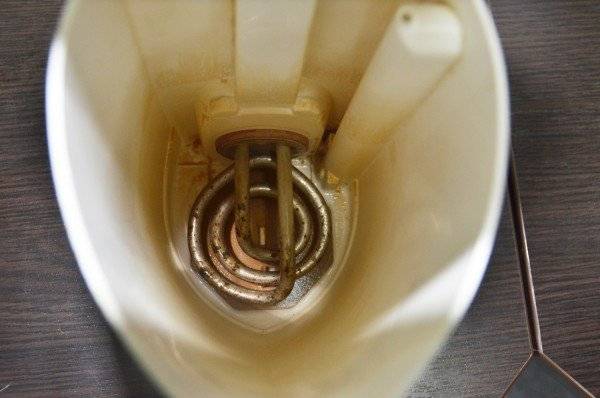
Try to keep the kettle free from limescale
So that you do not have to clean your kettle for too long over time, or even replace it with a new one, use a few preventive tips:
- do not wait until the scale becomes too thick, less sediment is much easier to remove;
- rinse the kettle every day by wiping it with a sponge;
- use soft water for boiling, purified through a filter, and if possible - then purchased, in gallons;
- do not boil water again - this significantly increases scale;
- drain the water from the kettle after each boil, do not leave it overnight.
The kettle should be cleaned, even if it is brand new, just purchased. Factory processing leaves a plaque on the walls with an unpleasant odor. Having filled the container, boil the water several times until the smell disappears completely. 3 tablespoons of baking soda will help speed up the process - this will be enough to cope with the unpleasant aroma in one boil.
To combat the smell of plastic from a new electric kettle, bay leaves are perfect. Pour half the bag into a full container and boil twice. Then drain and rinse thoroughly in cold water.
Sugar will help remove the smell in a stainless steel kettle. Dissolve two pieces of refined sugar in boiled water and leave for half an hour. Then drain the water, pour in a new one and boil again.
How to remove from an electric kettle
Electric kettles suffer from the appearance of rust on the spiral. This prevents the heating element from working at full capacity, and over time the device will fail. It is necessary to clean the inside of the container from rusty deposits in time.
Folk methods
The sediment on the walls of an electric kettle made of metal can be easily removed with the help of acids. Usually, they use those substances that every housewife has at home.
Vinegar
A concentrated solution of acetic acid is poured into a kettle flask, the device is turned on. It is necessary to boil the liquid so that the rust layer is gone. It is necessary to rinse the inside of the dishes in several waters. Then boil clean water to remove acid residues and odors. Open the window while cleaning to dissipate the vinegar smell.
The substance should be used carefully so that the acid does not get on the skin or burn the respiratory tract.
Lemon acid
Minor rust stains can be removed with citric acid:
- Half a liter of water is heated in a kettle.
- Pour in 2 tablespoons of citric acid.
- Boil for 5-10 minutes.
- After turning off the device, pour out the water.
- Wipe with a damp sponge the places where the rust was.
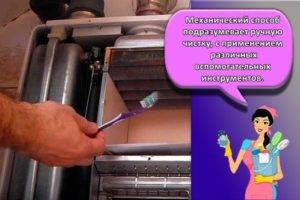
You can get rid of the rust with a slice of lemon by dropping it into hot water and boiling it.
Brine
Effectively dissolve the rusty acid residue contained in the pickle or cabbage brine. From the jar, fill the flask of the kettle with brine, turn on the device. It is necessary to boil for several minutes so that the rust layer becomes soft and easily separates from the spiral, the walls. Then they rinse the dishes, wipe dry.
Carbonated drinks
A feature of orthophosphoric acid contained in gas-saturated drinks is the ability to remove salts and oxides. You can pour Coca-Cola or Fanta into the electric kettle. Before this, the drink should be allowed to settle so that some of the gases are gone. Boil water for 10-15 minutes, then leave for half an hour and drain the liquid.
Vinegar and soda
This method will help remove rusty deposits on the spirals of both metal and plastic teapots. Water up to half a liter is poured into the device, 200 ml of vinegar and a tablespoon of baking soda must be added there. After waiting for the soda quenching reaction to stop, turn on the device and boil for several minutes. At the end, you need to rinse the flask well to remove iron oxide particles.
Potato peelings
The peel removed from the potato during peeling is washed with water. It is folded inside an electric kettle, filled with water. Boiling is carried out for several minutes.Then cool slightly, drain the liquid with potato peelings. Rinse the flask with clean water.
Household chemicals
The effectiveness of chemicals against scale and rust is higher than acid compositions. It is necessary to choose such household chemical goods so that they are safe, completely destroy deposits inside electrical appliances.
Pulsar Kalk Free
The liquid contains phosphoric acid and some non-ionic surfactants. The working solution of the liquid is poured into the kettle, leaving for 5-7 minutes. Then the container is rinsed with clean water.
The tool acts delicately. It is applied to areas damaged by rust and kept for a while. Then the remnants of rusty deposits are washed off.
Original ways to remove rusty deposits
Some housewives clean teapots using available tools. If the rust is barely noticeable, you can get rid of it in the most unusual way:
- Pour laundry detergent onto a damp surface and leave for 20 minutes. Then rub it well with half a potato. After thorough rinsing with water, the kettle is ready for use.
- You can clean it from rusty deposits inside with Coca-Cola, just pour it over with a drink and leave it overnight. All that remains is to rub it with a sponge and soap and rinse with water.
- Using pickle from canned cucumbers or tomatoes also removes rusty deposits in a metal teapot. The amount of vinegar or citric acid in the filling of these vegetables during canning is quite enough for this procedure. It is necessary to pour them over the dishes, bring to a boil, then cool, drain, wash thoroughly until the specific smell is completely removed.
- Sour milk can also clean the kettle. It is enough to pour in one third of the volume, boil and leave for a while.
The popular way is to clean rust and scale by peeling potatoes, apples and pears. The washed cleanings are placed in an enamel or steel teapot, water is added and heated to a boil. Then it is turned off, left for several hours, everything is drained and boiled with clean water. All formations inside the dishes are washed out.
To prevent rusty deposits in the kettle, rinse it after each boil. If the water is hard and has a high iron content, it is best to install a filter at home. To indulge in a fragrant cup of coffee or tea, use bottled water.
Boiling water in a kettle leads to various deposits inside the dishes. It can be limescale and rust. They arise as a result of poor-quality water, poor care of kitchen utensils. You need to know how to clean the inside of the kettle from rust in order to improve the quality of the drink and extend the life of the product.
How to clean a burnt teapot
When heated, a layer of burning produces toxic substances that are hazardous to health. In addition, the teapot is not aesthetically pleasing. If your kettle burns out, then you just need to know how to clean it.
Now in stores there is a very wide selection of cleaning products. For example "Sunklin". It's easy to use: apply to the surface and leave for a few minutes, then thoroughly wash the kettle. Always use a paste and a soft sponge to avoid scratching the surface. Of course, you can do without chemistry using folk remedies, but this process can be more laborious.
You need to take a large pot that would fit the kettle. We prepare a special solution. For 10 liters of water, 100 grams of soda and 80 grams of silicate glue. You can replace these ingredients with grated laundry soap. We immerse the kettle in a saucepan with the solution and bring to a boil. Let cool. With a cooled solution, use a sponge to remove carbon deposits.
How can you clean the outside of the kettle? A thin layer of burning can be removed with damp salt. Or you can prepare a solution: 1 teaspoon of salt and 1 table. a spoonful of vinegar, which will help remove fumes from the kettle.
Activated carbon will help to clear the aluminum kettle from burning. Moisten the surface of 10-15 tablets, crush the kettle, apply to problem areas. After 40-60 minutes, wipe off the burn, rinse with water.
The most effective descaling agents and recipes for them
Scale is the main enemy of any household heating device. In the arsenal of experienced housewives, there are many proven folk recipes against scale that are worth adopting.
Lemon acid
"Lemon" acts as an excellent solvent, effectively destroying lime compounds.
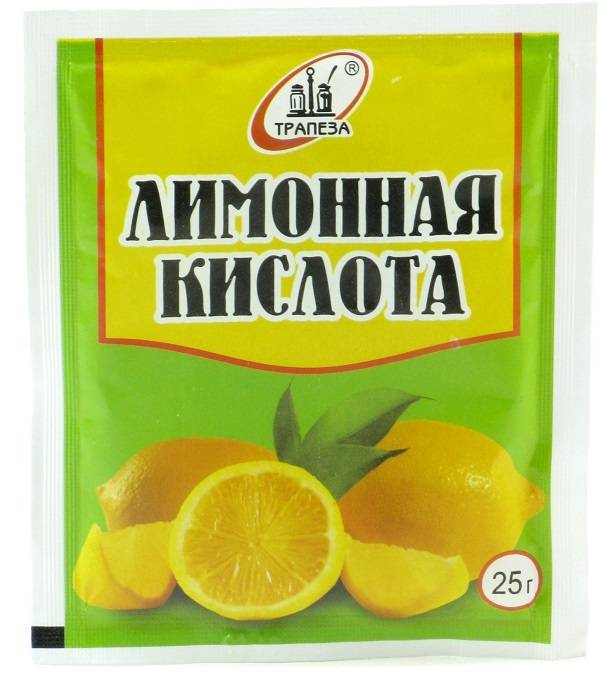 How to clean a kettle with citric acid:
How to clean a kettle with citric acid:
- Fill the appliance with water up to the scale level.
- Pour lemon powder into the water at the rate of 1 table. spoon for 1 liter of liquid.
- Leave the acid to work for 4-5 hours.
- Drain the water with the dissolved plaque, rinse the kettle, fill it with clean water and boil.
Citric acid can also help get rid of refrigerator odors, as discussed in this article.
Sodium bicarbonate, or simply baking soda, is a unique ingredient. It disinfects and cleans surfaces, loosens limescale, has bleaching and polishing properties.

How to get rid of limescale with baking soda:
- Fill the kettle with water and add soda powder - 1 table. 500 ml spoon.
- Switch on the device and bring the solution to a boil.
- Leave the liquid inside for another 20 minutes, then drain.
To remove a thick layer of scale, the soda solution is kept in a kettle for up to 2 hours, and if necessary, the whole procedure is repeated until the heating element is clean.
Baking soda can also help clean your electric oven. from the fat inside... The use of soda ash can help clean the oven from grease, detailed cleaning instructions are in this article.
Salt and soda
1 large spoonful of salt and 2 tablespoons are poured into an electric kettle. tablespoons of soda and pour water up to the upper mark.
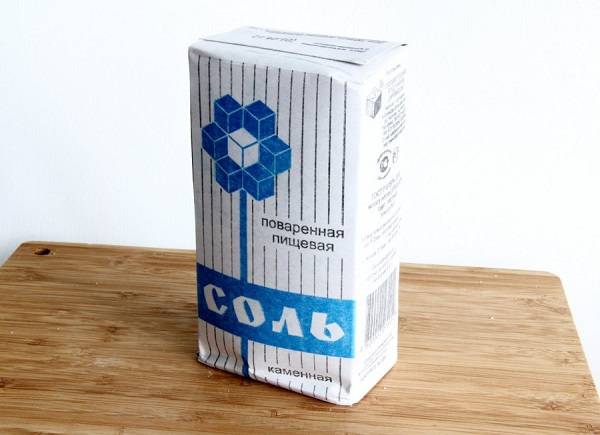
Bring the water to a boil and do not drain, but leave it for 10-15 minutes so that the salt mixture has time to dissolve the scale.
Then rinse the device under running water, and remove the remaining plaque with a soft sponge. If the scale is not rubbed off well, the boiling procedure is repeated again.
And yet, using this recipe, you can get rid of the smell in the multicooker.
Vinegar
Method number 1
- The electric kettle is filled with cold water and vinegar is added. For each liter of liquid, you will need 100 ml of 9% table vinegar. You can replace it with vinegar essence - it is more concentrated, so one tablespoon is enough for a liter of water.
- The water is boiled and left for 10-15 minutes - during this time the scale layer will become looser and it can be removed with a sponge under running water.
- The kettle is rinsed several times to remove the acid smell.
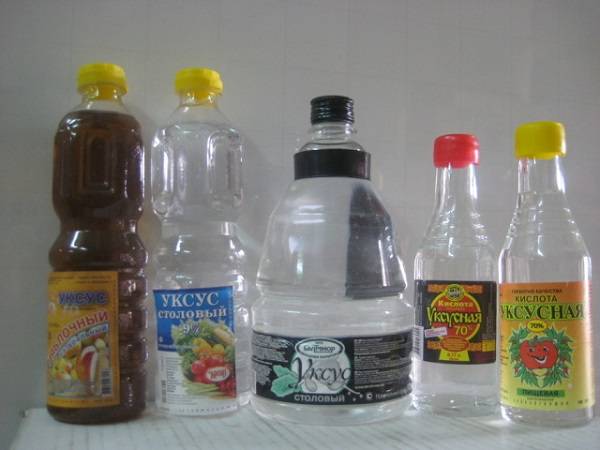
Method number 2
- Water is poured into the container so that its level reaches one third.
- Add 2 table. tablespoons of vinegar and one tablet of crushed ascorbic acid.
- The resulting solution is brought to a boil and left to stand for 25 minutes.
- Then the liquid is poured out and the inner surface is washed to remove the remaining solution.
Vinegar can also be excellent for cleaning the outside of the refrigerator, detailed instructions can be found here.
Brine
The brine, which contains vinegar, "works" effectively - its effect will be the same as that of a solution of vinegar essence. Moreover, vinegar can be any - wine, apple, table - it contains acid that can corrode limescale.
Thanks to solutions containing vinegar, the kettle is not only able to be descaled, but also to give it a radiant shine.
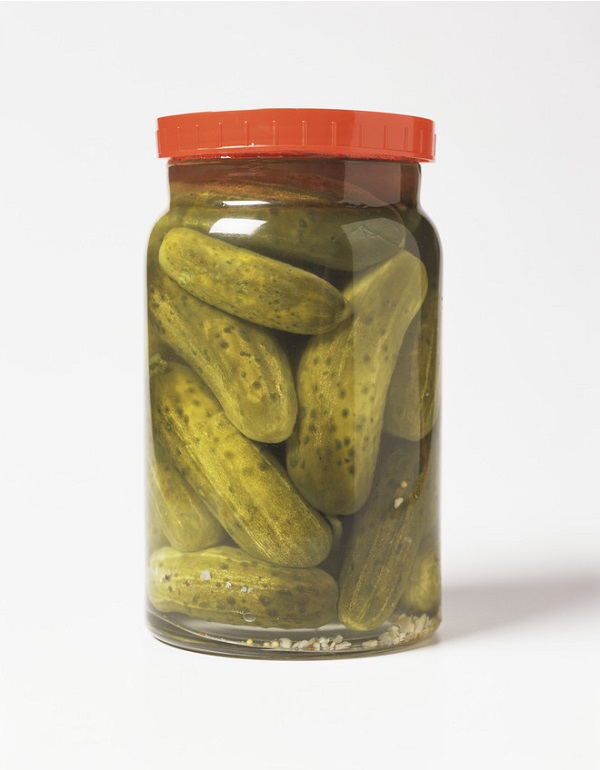
The algorithm of actions is simple - the brine is poured into the tank to the desired level and brought to a boil. You need to wait for the boiled solution to cool down and wash the container with clean cool water.
Carbonated drinks
The anti-lime properties of soda are due to the content of carbon dioxide and phosphoric acid, which fight against mineral deposits.For this purpose, it is recommended to use colorless drinks such as "Sprite". Colored soda leaves behind stains that will be difficult to clean, especially if the kettle is made of plastic.
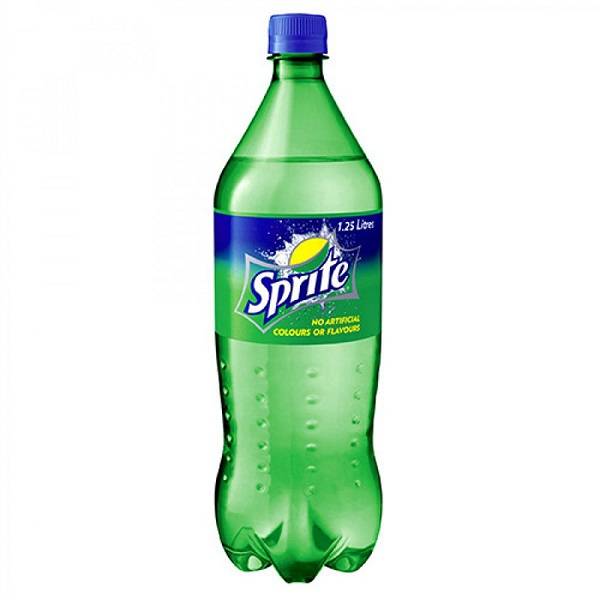
Previously, the bottle with the drink must be opened and left for several hours to allow some of the gases to escape. Then fill the kettle with soda and boil. After 15 minutes, the drink is discarded and the device is thoroughly rinsed.
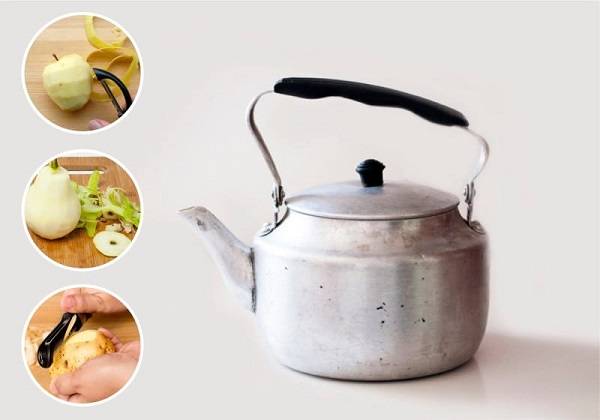
Adherents of everything natural should like this method of descaling:
- Prepare peelings from apples, pears or potatoes - they should be free of rot and pests.
- Wash cleaning under running water to remove dirt.
- Pour the peel into the reservoir of an electric kettle, add water and boil.
- Leave for 2 hours, then wash the dishes.
We remove rust, fumes and grease
Limescale is not the only nuisance that can happen to your kettle. Rust, solidified fat, burnt areas often appear on any kitchen surface, and dishes are no exception. And all these contaminants act to the detriment of helping each other: scale destroys metal surfaces, leading to rust and burning, fumes and rust attract fat to themselves and "fix" new scale. Therefore, if you really clean the kettle, then completely, saving it from all the troubles at once.
Rust should be cleaned up as soon as you notice signs of rust. Sprinkle some washing or cleaning powder over the rusty stain and let sit for 20 minutes. Then wipe the problem area with half a potato. Then rinse the kettle thoroughly under running water.
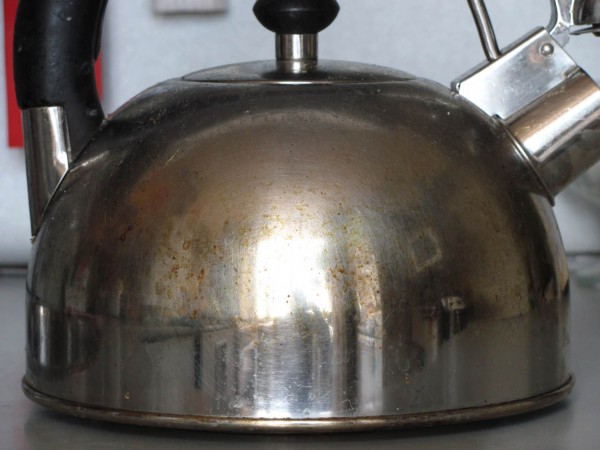
Timely clean rust from the metal kettle
In addition to the fact that the smoke gives the dishes an unaesthetic look, its layer, when heated, releases toxic substances. Therefore, the burnt kettle must be cleaned immediately.
- Use a household cleaner, this is the easiest option. Apply it to the surface and let it sit for 15-20 minutes, then rinse the kettle in water.
- Get a large pot that will fit the entire kettle. Prepare a solution: 10 liters of water, 100 grams of soda, 80 grams of silicate glue (it can be replaced with grated laundry soap). Bring the pot with the solution and the kettle immersed in it to a boil, let cool. After that, clean the surface from carbon deposits with a sponge.
- A thin layer of external carbon can be easily removed with wet salt or a solution: 1 tsp. salt per 1 tbsp. vinegar.
- Activated carbon will cope with the fumes on the aluminum kettle. Crush 10-15 tablets and apply evenly to the moistened surface. After an hour, dry thoroughly and rinse with water.
If you don't want to use chemicals to remove grease from the kettle, use baking soda to wipe down the problem areas. In case of an advanced stage, a solution will help you:
- 1 tbsp vinegar;
- 1 tsp salt;
- 1 tsp soda.
Wipe dried fat with it and rinse.
Home cleansing principles
The maintenance tips for stainless steel are very simple. It is not difficult to observe them.
What not to use
The list of tools and devices that cannot be used when using stainless steel cookware:
- Dishwasher;
- metal sponge;
- cleaner containing abrasive components.
How to use baking soda and salt
Salt and soda are indispensable care products for stainless steel dishes. The principle of their application is simple:
- the product is washed;
- soda, salt or their mixture is applied to the area of contamination;
- rub the powder in a circular motion.
After cleaning, the item is rinsed with water and wiped off with a towel.
Timeliness
Regular cleaning of stainless steel pans eliminates the appearance of stubborn stains. It takes little time to remove fresh dirt.
So that there are no divorces
After each wash, wipe the dishes dry with a kitchen towel. There are no stains on a clean, dry surface.
Teapots
These small teapots made of glass, ceramic or plastic require no less maintenance than those in which we boil water. They also accumulate scale, especially in the spout and on the folds, and this plaque is very difficult to remove. And he, in turn, can lead to the appearance of extraneous unpleasant odors, which is simply unacceptable for tasty, aromatic and healthy tea.
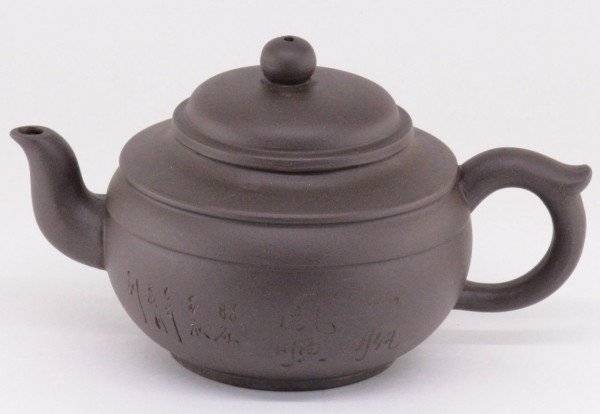
Teapots also need maintenance
Use a method that will help get rid of both plaque and excess odor, and at the same time from harmful bacteria that are so fond of settling in third-party impurities. Boil water in a large saucepan, add 1 cup vinegar and 4 tablespoons of baking soda. Submerge the teapot in water for 20-30 minutes. If it is made of heat-resistant ceramic, then you can boil it. Rinse thoroughly and pat dry. Excess odors and build-up plaque will go away.
If the sediment on the teapot is old, rub it with dry baking soda or fine salt after washing. You can also use regular sand.

